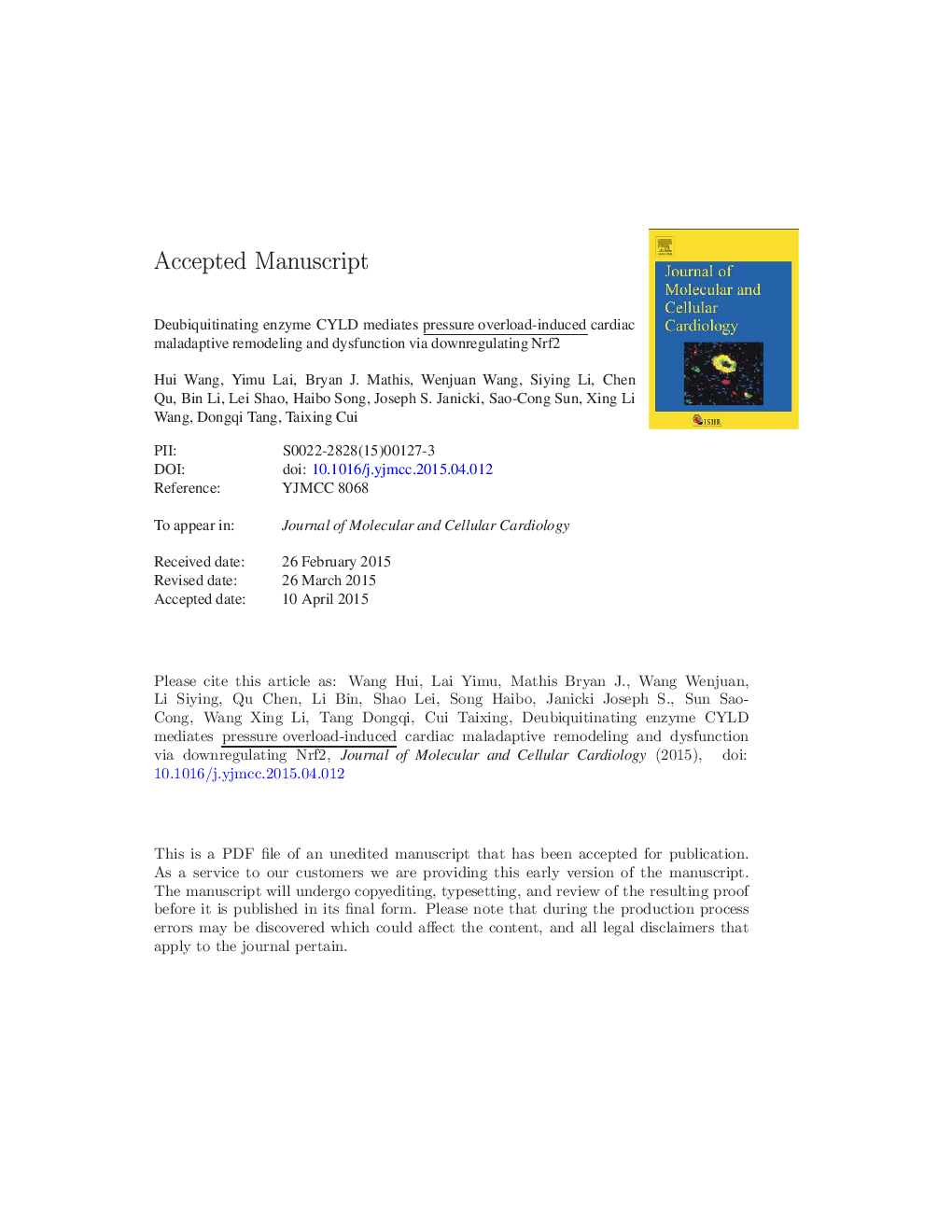| کد مقاله | کد نشریه | سال انتشار | مقاله انگلیسی | نسخه تمام متن |
|---|---|---|---|---|
| 8474269 | 1550421 | 2015 | 28 صفحه PDF | دانلود رایگان |
عنوان انگلیسی مقاله ISI
Deubiquitinating enzyme CYLD mediates pressure overload-induced cardiac maladaptive remodeling and dysfunction via downregulating Nrf2
دانلود مقاله + سفارش ترجمه
دانلود مقاله ISI انگلیسی
رایگان برای ایرانیان
کلمات کلیدی
موضوعات مرتبط
علوم زیستی و بیوفناوری
بیوشیمی، ژنتیک و زیست شناسی مولکولی
بیولوژی سلول
پیش نمایش صفحه اول مقاله

چکیده انگلیسی
Ubiquitin proteasome system (UPS) consists of ubiquitin, ubiquitin-activating enzymes (E1s), ubiquitin-conjugating enzymes (E2s), ubiquitin ligases (E3s), proteasomes, and deubiquitinating enzymes (DUBs). Ubiquitin, E1s, several E2s, E3s, and proteasomes play an important role in the regulation of cardiac homeostasis and dysfunction; however, less is known about the role of DUBs in the heart. Here, we uncovered a crucial role of cyclindromatosis (CYLD), a DUB, in mediating cardiac maladaptive remodeling and dysfunction. CYLD expression was dramatically upregulated in the cardiomyocytes of hypertrophic and failing human and murine hearts. Knockout of CYLD improved survival rate and alleviated cardiac hypertrophy, fibrosis, apoptosis, oxidative stress, and dysfunction in mice that were subjected to sustained pressure overload induced by transverse aortic constriction. Deep sequencing and gene array analyses revealed that the most dramatically changed genes are those involving in the free radical scavenging pathway and cardiovascular disease, including fos, jun, myc, and nuclear factor erythroid-2 related factor 2 (Nrf2) in the heart. Moreover, knockdown of CYLD enhanced mitogen-activated protein kinase (MAPK) ERK- and p38-mediated expression of c-jun, c-fos, and c-myc, which govern Nrf2 expression in cardiomyocytes. The CYLD deficiency-induced suppression of reactive oxygen species (ROS) formation, death and hypertrophy in cardiomyocytes was blocked by additional knockdown of Nrf2. Taken together, our findings demonstrate for the first time that CYLD mediates cardiac maladaptive remodeling and dysfunction, most likely via enhancing myocardial oxidative stress in response to pressure overload. At the molecular level, CYLD interrupts the ERK- and p38-/AP-1 and c-Myc pathways to suppress Nrf2-operated antioxidative capacity, thereby enhancing oxidative stress in the heart.
ناشر
Database: Elsevier - ScienceDirect (ساینس دایرکت)
Journal: Journal of Molecular and Cellular Cardiology - Volume 84, July 2015, Pages 143-153
Journal: Journal of Molecular and Cellular Cardiology - Volume 84, July 2015, Pages 143-153
نویسندگان
Hui Wang, Yimu Lai, Bryan J. Mathis, Wenjuan Wang, Siying Li, Chen Qu, Bin Li, Lei Shao, Haibo Song, Joseph S. Janicki, Sao-Cong Sun, Xing Li Wang, Dongqi Tang, Taixing Cui,